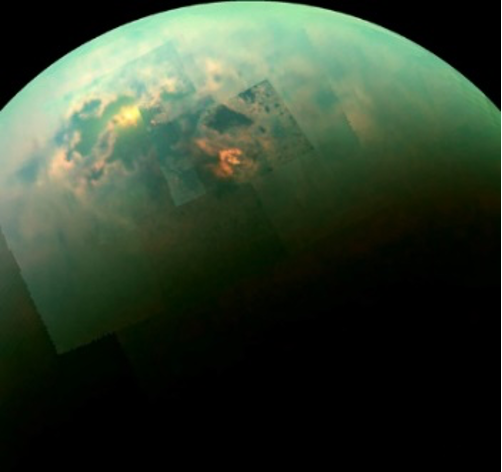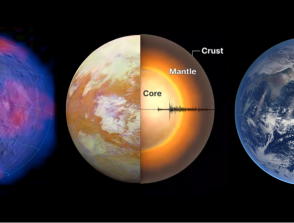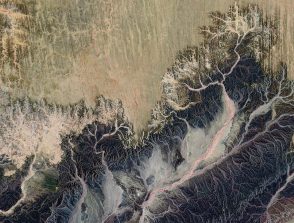ANR project : 3D radiative transfer in cloudy planetary atmospheres: applications to Titan, Venus and Mars

Start: 01/01/2021 - End: 31/12/2025
National partnership
Coordinators : Sébastien Rodriguez, Sandrine Vinatier
Host institutions :
LESIA
Partner institutions :
LESIA, LMD, GSMA, LATMOS, LAPLACE & start-up MESOSTAR
Related teams :
Planetology and Space Sciences
Related themes :
Earth System Science
The main objective of this project is to develop a full 3D radiative transfer (RT) model in spherical geometry for the study of horizontally heterogeneous planetary atmospheres (i.e., including clouds, haze and gas latitudinal and longitudinal variations) and surfaces (i.e., including high horizontal albedo contrasts) with a fast high resolution treatment of the spectral energy distribution. The need for such a model arises from increasingly detailed spectroscopic observations of planets and from developments of more and more sophisticated models built to analyze data or to model correctly climatic systems. This RT model is still lacking in the community and is essential to analyze data of polar regions of planets (including surface and atmosphere) where spherical geometry is mandatory, to study horizontal heterogeneities and to make correct predictions of thermal structures in winter polar regions in climate models. Observations of Titan and Venus, which both have thick hazy and cloudy atmospheres, as well as Mars atmosphere, which contains dust and localized clouds like Titan, albeit for a thin-atmosphere case, will be used to construct a versatile 3D spherical RT model dealing with horizontal (latitude and longitude) heterogeneity that could further be applied to other atmospheres and different types of observations (e.g., observations of the sky from the surface of Titan by the Dragonfly mission in 2034). Development of this 3D spherical RT model treating opacity heterogeneities accurately (hereafter “3D heterogeneous spherical RT model” or “3D-HSRT model”) is the core of this ANR project. Existing RT model is highly time consuming and therefore currently not used in planetary science. Available RT codes also usually consider homogeneous atmospheric layers (not suitable to study cloudy planetary atmospheres) with pseudo-spheric geometry (not suitable for observations with emergence angle larger than 60°, which are commonly encountered for planetary observations probing high latitudes of the target planet). To overcome these difficulties, our consortium will work with the start’up Meso-Star (https://www.meso-star.com/fr/), expert in high speed RT transfer modeling, who has developed a new RT approach to highly accelerate radiative transfer calculations considering high spectral resolution including thermal emission and scattered light in a Monte Carlo treatment. The new 3D-HSRT tool will be open source and made available for the community under Gnu General Public License. It will be used in the RaD3-net project to answer specific questions regarding the atmospheres of the cloudy objects Titan, Venus and Mars, which would not be answered without this new RT tool.
Two primary scientific objectives regarding Titan will focus on:
– unveil the seasonal cycles of organic chemistry from the surface to the stratosphere, by characterizing the surface composition and the haze and cloud layers in the troposphere and stratosphere of Titan’s polar region, where tropospheric convective clouds and massive polar stratospheric clouds (with potential precipitations) are observed above lacustrine regions during several years. These studies will be mostly based on the analysis of Cassini atmospheric and surface spectro-images acquired in near-infrared at high latitudes with large incidence and emergence angles, which are currently unexploited. Our objective is to characterize the seasonal changes of surface albedo under potential evaporation and/or precipitations from winter to summer, analyze the composition and physical properties of polar tropospheric convective clouds mainly active during summer, and to determine the chemical composition of polar stratospheric clouds observed inside the polar vortex during autumn and winter.
– allow for correct modeling of climate in winter polar region in the Titan IPSL-Global Climate Model (GCM), which is a fundamental lack in current climatic models. This will allow us to accurately simulate the radiative budget of polar regions and particularly inside the polar vortex during polar night in which the radiative impact of the massive stratospheric polar clouds and high molecular and haze enrichments are not correctly modeled in current GCMs. This more accurate simulation of polar region radiative budget is crucial to accurately represent the atmospheric thermal structure and, further, the resulting global dynamics.
Secondary scientific objectives will focus on questions related to the atmosphere of Venus and Mars:
– unveil the chemistry-microphysics interplay below and above Venus clouds using Venus Express (VEx) data (in the frame of preparing the ESA/Envision data analysis). Venus clouds are indeed known to exhibit strong horizontal contrasts on various length scales, whether in the backscattered UV sunlight at cloud top (where these contrasts are caused by the so-called “UV absorber” whose composition and nature is still unknown) or in the thermal near infrared radiation (where contrasts are caused by the varying optical thickness of the lower cloud layer). This horizontal heterogeneity, most likely extending to unresolved smaller scales, is not yet taken into account by existing forward radiative transfer models used to measure the minor gaseous species (especially those involved in sulfur cycle and heterogeneous aerosol chemistry) and constrain cloud properties (e.g. particle size distribution and composition), although multiple scattering dominates in the broader cloud region. In the context of orbital and/or in situ studies of Venus atmosphere foreseen for the next decade (e.g. ISRO’s Shukrayaan; ESA’s EnVision and NASA’s VERITAS and DAVINCI+ if selected), this possible shortcoming in remote spectroscopic analysis must be first assessed properly, and then corrected if necessary.
– decipher the structure of the Martian winter polar vortices and the solar terminators to reveal the complex structures of clouds and photochemical species in these zones of strong gradients: The polar atmosphere on Mars develops strong polar vortices during the winter, in a similar manner as on Titan (and Earth). These vortices are created by the strong latitudinal temperature contrasts that lead to a formation of high wind speed jet streams around the poles. The temperature and wind gradients at the vortex edges lead to the polar atmosphere being isolated from its surroundings. The winter polar vortex on Mars is so cold that the main atmospheric constituent, CO2, condenses as clouds (producing snowfall) and directly as ice on the surface of the polar cap. These phenomena are extremely difficult to study using remote sensing observations due to the 3D nature of the polar atmosphere. Such gradients also exist for chemical species at the solar terminators. In particular, ozone displays a strong diurnal cycle where the concentrations are the highest during the night and the lowest during daytime due to photochemical processes, and the day-night terminator region has the strongest gradient. Recent Mars missions (ESA/Mars Express, ESA/Trace Gas Orbiter) have used the technique of solar occultations to study chemical species. The inversion of occultation observations uses the so-called onion-peeling method, supposing a symmetry around the terminator. Solar occultation retrievals should take into account the strong gradients, but as of today the methods for doing this are mainly based on a simulated, pre-defined gradient. In both the polar vortex and solar terminator cases the gradient problem could only be treated accurately with a 3D-HSRT model such as proposed in this project. This model would allow for a reanalysis of data sets that have been underexploited due to the complexity of the problem.
Strength of the RaD3-net consortium is to combine expertise of radiative transfer modelers, planetary observers and climate modelers collaborating to develop a high speed 3D-HSRT tool and subsequently applying it to unresolved sciences cases related to the study of polar regions of Titan, Mars, and the heterogeneities of Venus’ cloud layer.





